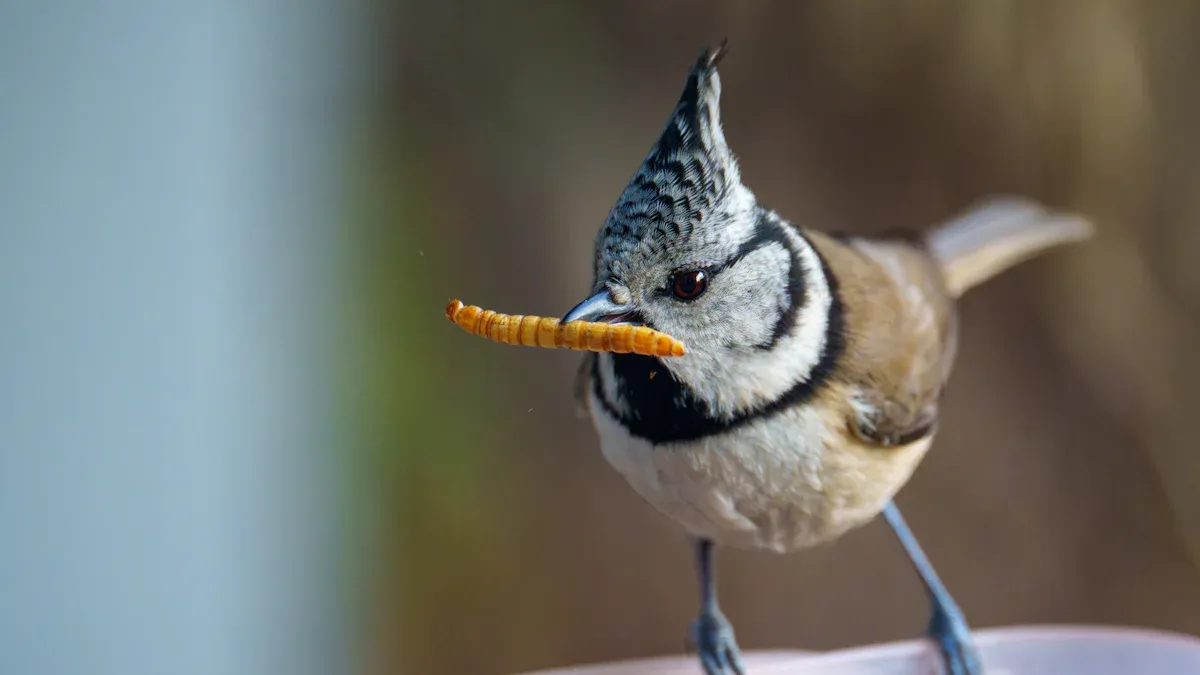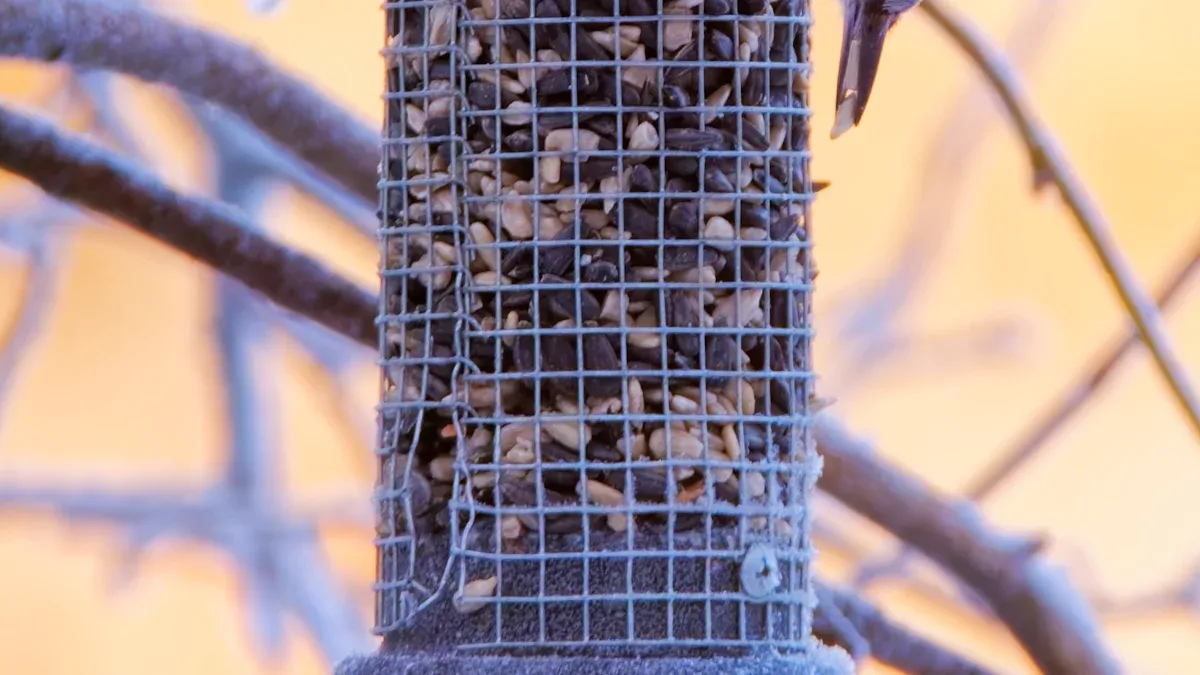
Dried mealworms are a game-changer for bird enthusiasts. Packed with 53% protein, they fuel energy and growth, especially for fledglings. Their essential minerals and vitamins promote feather health and survival. Easy to store and serve, they attract a variety of birds, making Dried Mealworms Wild Bird Food a must-have for any backyard feeder.
Key Takeaways
- Dried mealworms have 53% protein, giving birds energy and growth help.
- They are simple to store and serve, attracting many bird types.
- Soaking them in water makes them soft and hydrating, great in dry weather.
The Nutritional Value of Dried Mealworms Wild Bird Food
High Protein Content for Energy and Growth
Protein is essential for birds, especially during growth and breeding seasons. Dried mealworms contain an impressive 53% protein, making them a powerhouse for energy and development. This high protein content helps fledglings build strong muscles and supports their overall health. Additionally, the fat content of around 30% provides the energy birds need to stay active and maintain their metabolic functions. Compared to live mealworms, dried ones offer higher protein and fat levels, making them a superior choice for bird feeding.
| Nutrient | Dried Mealworms | Live Mealworms |
|---|---|---|
| Protein Content | Higher | Lower |
| Fat Content | Higher | Lower |
Essential Nutrients for Feather Health and Survival
Feathers are vital for birds, offering protection and aiding in flight. Dried Mealworms Wild Bird Food provides essential nutrients like amino acids and minerals that promote feather health. These nutrients help birds maintain vibrant plumage and ensure their survival in the wild. Healthy feathers also improve insulation, which is crucial during colder months. By including dried mealworms in their diet, bird enthusiasts can support their feathered friends’ well-being year-round.
Supporting Birds Year-Round, Especially in Harsh Weather
Dried mealworms are a reliable food source throughout the year. They are easy to store and provide consistent nutrition, even during harsh weather conditions. During winter, when natural food sources are scarce, dried mealworms help sustain bird populations. In dry weather, soaking them adds hydration, which is especially beneficial. Adding dried mealworms to feeding stations ensures birds have access to a varied diet, helping them thrive no matter the season.
- Dried mealworms can be fed year-round, offering a dependable food source.
- Soaking them enhances hydration, which is crucial during dry spells.
- Their high nutritional value supports birds during challenging weather.
By incorporating Dried Mealworms Wild Bird Food into their routine, bird lovers can make a meaningful difference in the lives of their backyard visitors.
Practical Tips for Feeding Dried Mealworms
Using Feeders and Trays for Mealworms
Feeders and trays are excellent tools for offering dried mealworms to birds. A shallow tray or platform feeder works best, as it allows birds to easily spot and access the mealworms. Placing the feeder near perches or existing feeding stations can make it even more inviting. This setup not only keeps the feeding area tidy but also helps prevent mealworms from scattering too far. For bird enthusiasts looking to attract a variety of species, feeders and trays are a simple yet effective solution.
Scattering Mealworms to Mimic Natural Foraging
Scattering dried mealworms on the ground mimics the natural foraging behavior of birds. Many species instinctively search for insects and worms in the soil, so this method feels familiar to them. Spread the mealworms in open areas or near shrubs to create a more natural feeding experience. This approach encourages birds to explore and forage, making their visit to your yard more engaging and rewarding.
Soaking Mealworms for Added Hydration
Soaking dried mealworms in warm water adds hydration, which is especially helpful during dry weather. To prepare, pour hot water into a heat-safe container, add the mealworms, and let them soak for 20-40 minutes. Once rehydrated, they become softer and easier for young birds to eat. This method not only provides much-needed moisture but also reduces mess during feeding.
Soaked mealworms are a lifesaver for birds during dry spells. They’re softer, making them easier for fledglings to swallow.
Mixing Mealworms with Birdseed for Variety
Combining dried mealworms with birdseed creates a diverse and appealing mix for your feathered visitors. This blend caters to different dietary preferences, attracting a wider range of species. Simply sprinkle mealworms into your regular birdseed mix or layer them in a feeder. The added variety keeps birds coming back for more, ensuring they receive a balanced diet.
Birds That Benefit from Dried Mealworms Wild Bird Food

Common Backyard Birds That Love Mealworms
Backyard birds like robins, bluebirds, and chickadees enjoy dried mealworms. These birds often search for insects in the wild, so mealworms feel like a natural treat. Sparrows and wrens also flock to feeders offering this protein-packed snack. Adding Dried Mealworms Wild Bird Food to a backyard feeding station can attract a lively mix of feathered visitors. It’s a simple way to bring more activity and color to any yard.
Seasonal and Migratory Birds Attracted by Mealworms
Seasonal and migratory birds benefit greatly from dried mealworms. During migration, birds need extra energy to fuel their long journeys. Mealworms provide the protein and fat they need to stay strong. Orioles, warblers, and even some woodpeckers stop by feeders with mealworms during their travels. Offering this food during migration seasons can help these birds recharge and continue their journey.
In experiments, it was observed that bluebirds and Carolina wrens preferred live mealworms, followed by soaked mealworms, and lastly dried mealworms when only dried options were available.
Supporting Nesting and Breeding Birds with Mealworms
Nesting and breeding birds rely on nutrient-rich food to raise their young. Dried mealworms are an excellent choice for parents feeding their chicks. They’re easy to digest and packed with protein, which helps chicks grow strong. Birds like robins and starlings often gather mealworms to bring back to their nests. By offering mealworms, bird enthusiasts can support the next generation of backyard birds.
Dried Mealworms vs. Other Bird Food Options
Comparing Dried Mealworms to Live Mealworms
Live mealworms may seem like a natural choice for birds, but they come with challenges. Handling live mealworms can be messy and time-consuming. They require proper storage, often needing refrigeration to stay alive. In contrast, dried mealworms are ready to use straight out of the bag. They don’t wriggle away, making them easier to manage. Birds still enjoy the same nutritional benefits, but without the hassle for the feeder. For those who want a convenient and effective option, dried mealworms are the clear winner.
Dried Mealworms vs. Calciworms: Which is Better?
Calciworms, another popular bird food, are rich in calcium, which supports bone health. However, they lack the high protein content found in dried mealworms. Protein is essential for energy and growth, especially during breeding and migration seasons. While calciworms have their benefits, dried mealworms offer a more balanced nutritional profile. They provide both protein and fat, making them a versatile choice for year-round feeding. For bird enthusiasts looking to support a variety of species, dried mealworms are the better option.
Why Dried Mealworms Are the Most Convenient Choice
Dried mealworms stand out for their ease of use. Unlike live mealworms, they don’t require special storage or handling.
Dried mealworms have an advantage in convenience as they require minimal handling. You simply need to pour them into a dish for the birds, eliminating the hassle of dealing with live mealworms.
This simplicity makes them perfect for beginners and seasoned bird feeders alike. Additionally, dried mealworms have a long shelf life, so they’re always ready when needed. With Dried Mealworms Wild Bird Food, feeding birds becomes a stress-free and enjoyable experience.
Storing and Preparing Dried Mealworms
Best Practices for Storing Mealworms to Maintain Freshness
Proper storage keeps dried mealworms fresh and nutritious for birds. They should be stored in an airtight container to prevent moisture and pests from spoiling them. A cool, dry place works best, but refrigeration or freezing can extend their shelf life even further. Keeping them away from direct sunlight also helps maintain their quality.
🛠️ Tip: If you’re storing mealworms in the freezer, let them thaw before feeding to avoid shocking the birds with cold food.
For those who prefer not to refrigerate, a pantry or cupboard works fine as long as it’s not too warm or humid. These simple steps ensure your mealworms stay fresh and ready to use whenever your feathered friends come calling.
Preparing Mealworms for Feeding Birds
Preparing dried mealworms is quick and easy. Soaking them in water for 30 minutes makes them softer and more appealing to birds. This process also adds hydration, which is especially helpful during dry seasons. To prepare, pour boiling water over the mealworms and let them soak for 30 minutes to an hour. For a softer texture, leave them in room-temperature water overnight.
Birds often prefer the texture of soaked mealworms because it mimics live ones. This small effort can make a big difference in attracting more birds to your yard.
Avoiding Overfeeding and Common Storage Mistakes
Overfeeding dried mealworms can lead to waste and attract unwanted pests. Offer small portions and adjust based on how quickly birds consume them. Avoid leaving mealworms out for too long, as they can become soggy or moldy.
Common storage mistakes include leaving mealworms in open containers or exposing them to heat and humidity. These conditions can cause spoilage and reduce their nutritional value. By following proper storage and feeding practices, you’ll keep your backyard birds happy and healthy.
Dried Mealworms Wild Bird Food offers unmatched benefits for backyard birds. Packed with protein, fat, and essential nutrients, they support growth, energy, and feather health. Their year-round availability ensures birds thrive in every season. Adding them to your routine creates a rewarding experience. Try them today and watch your yard come alive with activity!
🐦 Tip: Birds love variety! Combine mealworms with seeds to attract even more species.
FAQ
What types of birds are most attracted to dried mealworms?
Birds like bluebirds, robins, wrens, and chickadees love dried mealworms. These species naturally forage for insects, making mealworms an irresistible treat.
Can dried mealworms replace other bird food entirely?
No, dried mealworms should complement other foods. A mix of seeds, fruits, and mealworms provides a balanced diet for birds, supporting their health and energy needs.
How often should dried mealworms be offered to birds?
Offer mealworms in small portions daily or a few times a week. Adjust based on how quickly birds consume them to avoid waste or overfeeding.
🐦 Tip: Start with a handful of mealworms and observe how many birds visit your feeder!


